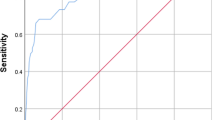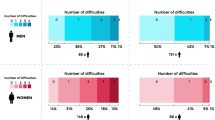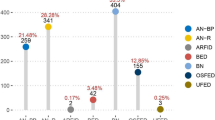Validity of the Adult Eating Behavior Questionnaire for adolescents treated in a weight management clinic
The Child and Adult Eating Behavior Questionnaires (CEBQ, AEBQ) are established measures of eating behaviors. However, no similar measure is available for adolescents. Prior research has validated the AEBQ in adult samples, and one study has explored using the measure with adolescents. However, no studies to date have examined the validity of the AEBQ in adolescent clinical populations. Furthermore, no studies have examined associations between the AEBQ and indicators of health status in adolescents.
Methods
A total of 280 adolescents (12–17 years old, 60% female) seen in a pediatric weight management clinic completed the AEBQ at intake. Confirmatory factor analysis (CFA) was conducted with AEBQ items to evaluate the model fit of one-, two-, seven-, and eight-factor structures. Intercorrelations between scale scores from AEBQ Food Approach and Food Avoidance domains were calculated. Associations of AEBQ scales with body mass index (BMI) and binge-eating behaviors were examined using Spearman Rho correlations and independent t-tests.
Results
CFAs revealed that the best fitting model was a seven-factor structure excluding the Hunger scale, although overall model fit was only marginally acceptable (X 2 = 980.94, CFI = 0.925, TLI = 0.915, RMSEA = 0.074). Intercorrelation analyses indicated that all Food Approach scales were significantly associated with one another (r = 0.243–0.654); Food Avoidance scales were inconsistently correlated (r = 0.034–0.439). No AEBQ scales were correlated with BMI (r = −0.101–0.082). Stronger links were found with binge eating; higher frequency binge-related behaviors were associated with higher Food Approach scores.
Conclusions
The seven-factor structure of AEBQ demonstrates a marginally acceptable fit for treatment-seeking adolescents with obesity. The Food Approach scales demonstrated more convergent validity than the Food Avoidance scales. The Food Approach scales also exhibited some clinical utility for identifying patients with increased risk for binge eating, which is a common target for behavioral intervention. Implications for maximizing the AEBQ’s potential for assessing eating behaviors in adolescents with obesity are discussed.
This is a preview of subscription content, access via your institution
Access options
Subscribe to this journal
Receive 12 print issues and online access
265,23 € per year
only 22,10 € per issue
Buy this article
- Purchase on SpringerLink
- Instant access to full article PDF
Prices may be subject to local taxes which are calculated during checkout
Similar content being viewed by others

Evaluation of psychometric properties of the eating restriction questionnaire and food involvement inventory in Iranian adults
Article Open access 20 August 2023

Low eating self-efficacy is associated with unfavorable eating behavior tendencies among individuals with overweight and obesity
Article Open access 12 May 2023

Network-based validation of the psychometric questionnaire EDI-3 for the assessment of eating disorders
Article Open access 28 January 2023
References
- Hales CM, Fryer CD, Carroll MD, Freedman DS, Ogden CL. Trends in obesity and severe obesity prevalence in US youth and adults by sex and age, 2007–2008 to 2015–2016. JAMA. 2018;319:1723–5. ArticlePubMedPubMed CentralGoogle Scholar
- Carnell S, Wardle J. Appetite and adiposity in children: evidence for a behavioral susceptibility theory of obesity. Am J Clin Nutr. 2008;88:22–9. ArticleCASPubMedGoogle Scholar
- Llewellyn C, Wardle J. Behavioral susceptibility to obesity: gene–environment interplay in the development of weight. Physiol Behav. 2015;152:494–501. ArticleCASPubMedGoogle Scholar
- Gross AC, Kaizer AM, Vock DM, Siddiqui S, Fox CK. Cognitive, emotional, and behavioral contributors to early childhood weight status. J Child Health Care. 2019;23:382–91. ArticlePubMedGoogle Scholar
- Jansen PW, Roza SJ, Jaddoe VW, Mackenbach JD, Raat H, Hofman A, et al. Children’s eating behavior, feeding practices of parents and weight problems in early childhood: results from the population-based Generation R Study. Int J Behav Nutr Phys Act. 2012;9:130. ArticlePubMedPubMed CentralGoogle Scholar
- Webber L, Hill C, Saxton J, Van Jaarsveld CH, Wardle J. Eating behaviour and weight in children. Int J Obes. 2009;33:21–8. ArticleCASGoogle Scholar
- Cooke LJ, Wardle J, Gibson EL, Sapochnik M, Sheiham A, Lawson M. Demographic, familial and trait predictors of fruit and vegetable consumption by pre-school children. Public Health Nutr. 2004;7:295–302. ArticleCASPubMedGoogle Scholar
- Russell CG, Worsley T. Associations between appetitive traits and food preferences in preschool children. Food Qual Prefer. 2016;52:172–8. ArticleGoogle Scholar
- Syrad H, Johnson L, Wardle J, Llewellyn CH. Appetitive traits and food intake patterns in early life. Am J Clin Nutr. 2016;103:231–5. ArticleCASPubMedGoogle Scholar
- Croker H, Cooke L, Wardle J. Appetitive behaviours of children attending obesity treatment. Appetite. 2011;57:525–9. ArticleCASPubMedGoogle Scholar
- Gross AC, Fox CK, Rudser KD, Foy AM, Kelly AS. Eating behaviours are different in youth with obesity and severe obesity. Clin Obes. 2016;6:68–72. ArticleCASPubMedGoogle Scholar
- Derks IP, Sijbrands EJ, Wake M, Qureshi F, van der Ende J, Hillegers MH, et al. Eating behavior and body composition across childhood: a prospective cohort study. Int J Behav Nutr Phys Act. 2018;15:96. ArticlePubMedPubMed CentralGoogle Scholar
- Steinsbekk S, Wichstrøm L. Predictors of change in BMI from the age of 4 to 8. J Pediatr Psychol. 2015;40:1056–64. ArticlePubMedGoogle Scholar
- Hayes JF, Altman M, Kolko RP, Balantekin KN, Holland JC, Stein RI, et al. Decreasing food fussiness in children with obesity leads to greater weight loss in family‐based treatment. Obesity. 2016;24:2158–63. ArticlePubMedGoogle Scholar
- Van Strien T. Causes of emotional eating and matched treatment of obesity. Curr Diab Rep. 2018;18:35. ArticlePubMedPubMed CentralGoogle Scholar
- Nathan BM, Rudser KD, Abuzzahab MJ, Fox CK, Coombes BJ, Bomberg EM, et al. Predictors of weight-loss response with glucagon-like peptide-1 receptor agonist treatment among adolescents with severe obesity. Clin Obes. 2016;6:73–8. ArticleCASPubMedGoogle Scholar
- Miller WC, Hering M, Cothran C, Croteau K, Dunlap R. After-school physical activity and eating behaviors of middle school students in relation to adult supervision. J Nutr Educ Behav. 2012;44:326–34. ArticlePubMedGoogle Scholar
- Reicks M, Banna J, Cluskey M, Gunther C, Hongu N, et al. Influence of parenting practices on eating behaviors of early adolescents during independent eating occasions: implications for obesity prevention. Nutrients. 2015;7:8783–801. ArticlePubMedPubMed CentralGoogle Scholar
- Wray‐Lake L, Crouter AC, McHale SM. Developmental patterns in decision‐making autonomy across middle childhood and adolescence: European American parents’ perspectives. Child Dev. 2010;81:636–51. ArticlePubMedPubMed CentralGoogle Scholar
- Ashcroft J, Semmler C, Carnell S, Van Jaarsveld CH, Wardle J. Continuity and stability of eating behaviour traits in children. Eur J Clin Nutr. 2008;62:985–90. ArticleCASPubMedGoogle Scholar
- Derks IP, Bolhuis K, Sijbrands EJ, Gaillard R, Hillegers MH, Jansen PW. Predictors and patterns of eating behaviors across childhood: results from The Generation R study. Appetite. 2019;141:104295. ArticlePubMedGoogle Scholar
- Decaluwé V, Braet C, Fairburn CG. Binge eating in obese children and adolescents. Int J Eat Disord. 2003;33:78–84. ArticlePubMedGoogle Scholar
- Johnson WG, Rohan KJ, Kirk AA. Prevalence and correlates of binge eating in white and African American adolescents. Eat Behav. 2002;3:179–89. ArticlePubMedGoogle Scholar
- Morgan CM, Yanovski SZ, Nguyen TT, McDuffie J, Sebring NG, Jorge MR, et al. Loss of control over eating, adiposity, and psychopathology in overweight children. Int J Eat Disord. 2002;31:430–41. ArticlePubMedPubMed CentralGoogle Scholar
- Wardle J, Guthrie CA, Sanderson S, Rapoport L. Development of the children’s eating behaviour questionnaire. J Child Psychol Psychiatry. 2001;42:963–70. ArticleCASPubMedGoogle Scholar
- Boswell N, Byrne R, Davies PS. Eating behavior traits associated with demographic variables and implications for obesity outcomes in early childhood. Appetite. 2018;120:482–90. ArticlePubMedGoogle Scholar
- Koch A, Pollatos O. Interoceptive sensitivity, body weight and eating behavior in children: a prospective study. Front Psychol. 2014;5:1003. ArticlePubMedPubMed CentralGoogle Scholar
- Sleddens EF, Kremers SP, Thijs C. The Children’s Eating Behaviour Questionnaire: factorial validity and association with body mass index in Dutch children aged 6–7. Int J Behav Nutr Phys Act. 2008;5:49. ArticlePubMedPubMed CentralGoogle Scholar
- Hunot C, Fildes A, Croker H, Llewellyn CH, Wardle J, Beeken RJ. Appetitive traits and relationships with BMI in adults: development of the Adult Eating Behaviour Questionnaire. Appetite. 2016;105:356–63. ArticlePubMedPubMed CentralGoogle Scholar
- Mallan KM, Fildes A, de la Piedad Garcia X, Drzezdzon J, Sampson M, et al. Appetitive traits associated with higher and lower body mass index: evaluating the validity of the adult eating behaviour questionnaire in an Australian sample. Int J Behav Nutr Phys Act. 2017;14:130. ArticlePubMedPubMed CentralGoogle Scholar
- Zickgraf HF, Rigby A. The Adult Eating Behaviour Questionnaire in a bariatric surgery‐seeking sample: Factor structure, convergent validity, and associations with BMI. Eur Eat Disord Rev. 2019;27:97–104. ArticlePubMedGoogle Scholar
- Van Strien T, Frijters JE, Bergers GP, Defares PB. The Dutch Eating Behavior Questionnaire (DEBQ) for assessment of restrained, emotional, and external eating behavior. Int J Eat Disord. 1986;5:295–315. ArticleGoogle Scholar
- Mitchell TB, Cushing CC, Amaro CM. Psychometric properties of the Power of Food Scale in a community sample of preadolescents and adolescents. J Child Fam Stud. 2016;25:2733–9. ArticleGoogle Scholar
- Johnson F, Wardle J, Griffith J. The adolescent food habits checklist: reliability and validity of a measure of healthy eating behaviour in adolescents. Eur J Clin Nutr. 2002;56:644–9. ArticleCASPubMedGoogle Scholar
- Hunot-Alexander CM, Beeken RJ, Fildes A, Croker H, Llewellyn CH, Steinsbekk S. Confirmation of the factor structure and reliability of the Adult Eating Behavior Questionnaire in an adolescent sample. Front Psychol. 2019;10:1991. ArticlePubMedPubMed CentralGoogle Scholar
- Elkins A, Zickgraf HF. Picky eating and food neophobia: Resemblance and agreement in parent/young adult dyads. Appetite. 2018;126:36–42. ArticlePubMedGoogle Scholar
- Gulati AK, Kaplan DW, Daniels SR. Clinical tracking of severely obese children: a new growth chart. Pediatrics. 2012;130:1136–40. ArticlePubMedPubMed CentralGoogle Scholar
- American Psychiatric Association. Diagnostic and statistical manual of mental disorders (DSM-5®). American Psychiatric Pub; 2013.
- Mundfrom DJ, Shaw DG, Ke TL. Minimum sample size recommendations for conducting factor analyses. Int J Test. 2005;5:159–68. ArticleGoogle Scholar
- Muthén LK, Muthén BO. Mplus User’s Guide, 8th ed. Los Angeles, CA: Muthén & Muthén; 1998;2017.
- Hu LT, Bentler PM. Cutoff criteria for fit indexes in covariance structure analysis: conventional criteria versus new alternatives. Struct Equ Modeling. 1999;6:1–55. ArticleGoogle Scholar
- Matsunaga M. How to factor-analyze your data right: do’s, don’ts, and how-to’s. Int J Psychol Res. 2010;3:97–110. ArticleGoogle Scholar
- Nunnally JC. Assessment of reliability. In: Psychometric theory. 2nd ed. New York: McGraw-Hill; 1979. p 245–6.
- Sonneville KR, Horton NJ, Micali N, Crosby RD, Swanson SA, Solmi F, et al. Longitudinal associations between binge eating and overeating and adverse outcomes among adolescents and young adults: does loss of control matter? JAMA Pediatr. 2013;167:149–55. ArticlePubMedPubMed CentralGoogle Scholar
- Toussi R, Fujioka K, Coleman KJ. Pre-and postsurgery behavioral compliance, patient health, and postbariatric surgical weight loss. Obes. 2009;17:996–1002. ArticleGoogle Scholar
- Kirk S, Armstrong S, King E, Trapp C, Grow M, Tucker J, et al. Establishment of the Pediatric Obesity Weight Evaluation Registry: a national research collaborative for identifying the optimal assessment and treatment of pediatric obesity. Child Obes. 2017;13:9–7. ArticlePubMedGoogle Scholar
Author information
Authors and Affiliations
- Department of Pediatrics, University of Minnesota Medical School, Minneapolis, MN, USA Stephen J. Molitor, Claudia K. Fox, Megan O. Bensignor & Amy C. Gross
- Center for Pediatric Obesity Medicine, University of Minnesota, Minneapolis, MN, USA Claudia K. Fox, Megan O. Bensignor & Amy C. Gross
- Stephen J. Molitor




